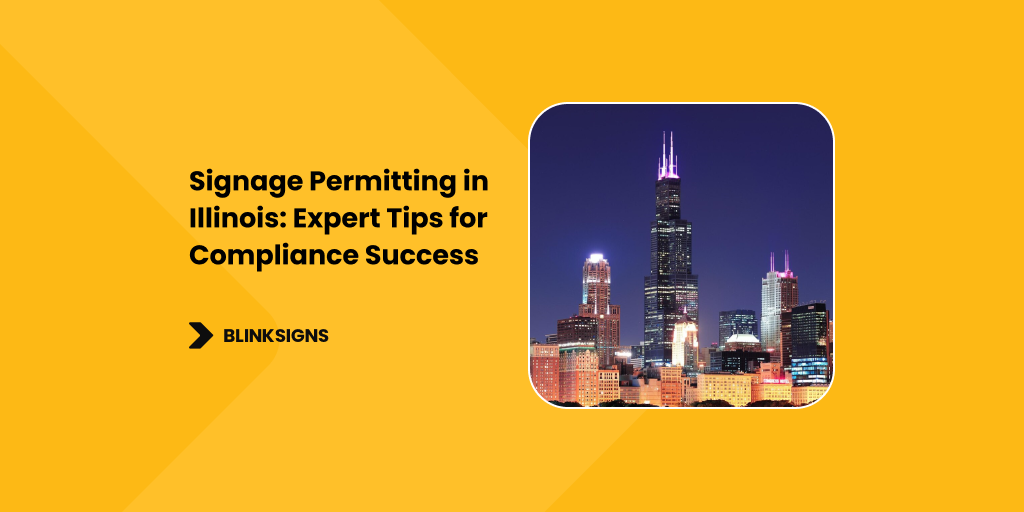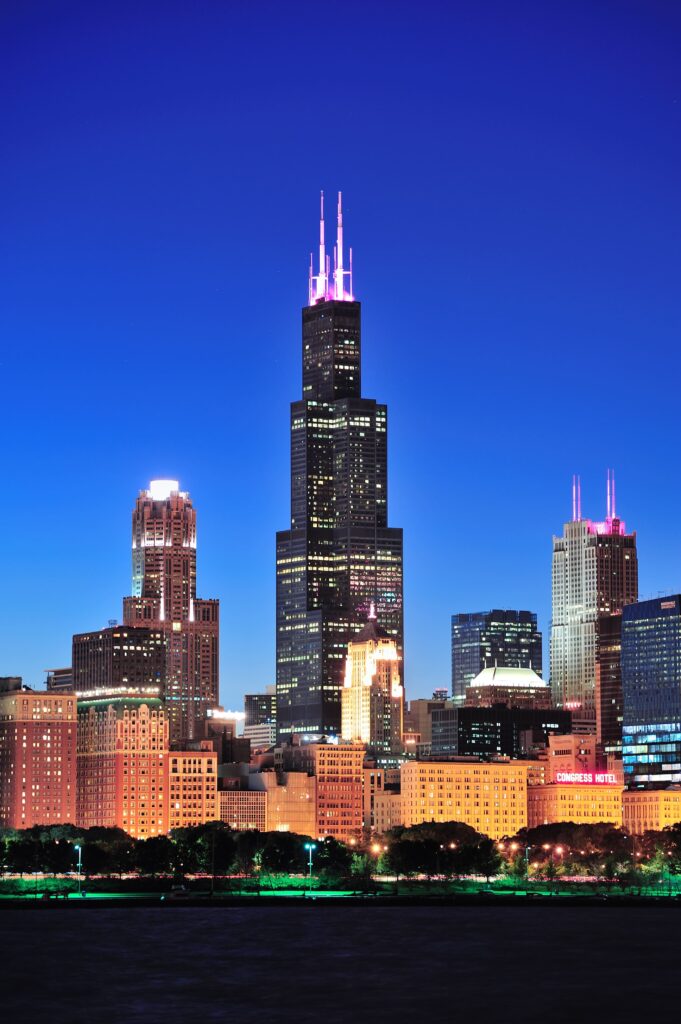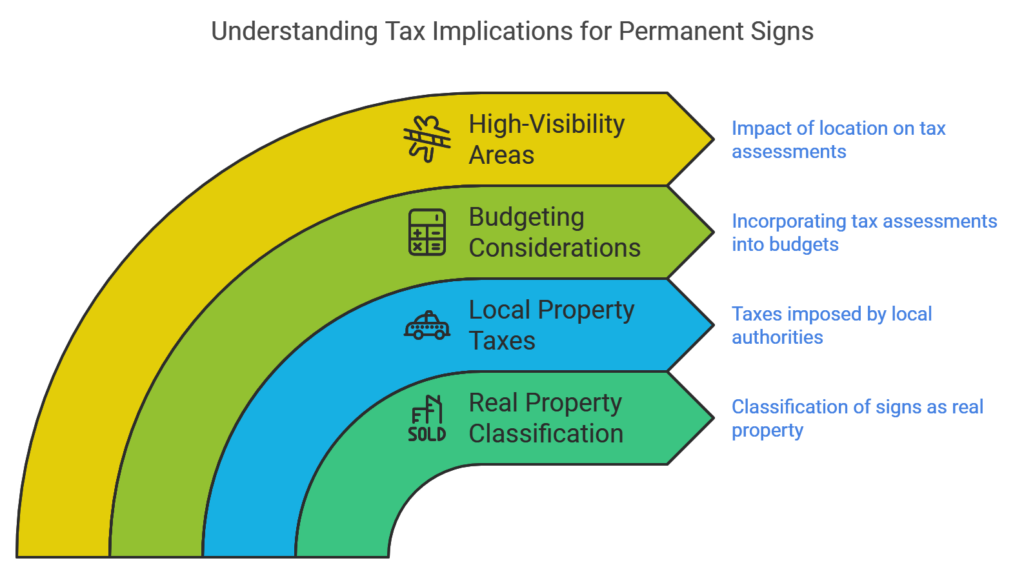
Signage Permitting in Illinois: Expert Tips for Compliance Success
In Illinois, where bustling cities meet scenic landscapes, well-placed signage is pivotal in helping businesses attract and inform customers. Signage isn’t just about visibility— it’s also about aligning with local codes to enhance aesthetic appeal, safety, and neighborhood integrity.

des-moines-iowa-usa-with-the-capitol-building
Importance of Signage Permitting
Obtaining the correct permits for signage is essential to ensure safety, avoid regulatory violations, and maintain property values. State and local bodies in Illinois, including the Illinois Department of Transportation (IDOT), enforce zoning ordinances and signage codes to keep visual clutter in check and enhance community aesthetics. Compliance prevents hazards such as obstructed views and overly bright signs that can cause driver distraction. Proper permitting also supports the longevity of your signage by ensuring it meets structural and design requirements.
Key Regulatory Bodies
Businesses looking to install signage in Illinois must navigate a variety of regulatory authorities. Primary oversight includes IDOT, which regulates signage near highways, local city and county zoning boards that enforce municipal codes, and, in some areas, the Illinois Historic Preservation Agency. Understanding the role of these agencies is crucial for businesses aiming to stay compliant while creating impactful, permitted signage.
Understanding Sign Permits and Regulatory Authorities in Illinois
What is a Sign Permit?
A sign permit is an official authorization from local or state authorities, certifying that signage complies with Illinois’s safety, zoning, and aesthetic regulations. Requirements may vary by sign type, size, and location, but all permits ensure the sign adheres to standards that promote public safety and neighborhood harmony.
Primary Regulatory Authorities
In Illinois, several entities oversee signage regulation:
- Illinois Department of Transportation (IDOT): Oversees signage along state highways, enforcing rules on size, spacing, and illumination.
- City and County Building Departments: These departments are responsible for local permits and ensure signs comply with local zoning codes.
- Zoning and Planning Boards: These boards oversee signs within designated zones and enforce ordinances on height, setback, and type.
- Illinois Historic Preservation Agency: Approves signage in historic districts to protect Illinois’s architectural heritage.
Legal Basis for Sign Regulation
The Illinois Outdoor Advertising Act, local zoning ordinances, and the Illinois Municipal Code govern signage regulation in Illinois. These laws collectively restrict the signs’ placement, content, and lighting, especially near highways and scenic areas, to maintain road safety and aesthetic appeal.
Types of Signage and Their Specific Requirements
On-Premise vs. Off-Premise Signs
- On-Premise Signs are located on the business property they represent, such as wall or monument signs outside a storefront. Local zoning ordinances regulate their size, height, and spacing.
- Off-Premise Signs, including billboards, advertise businesses or services located elsewhere. IDOT heavily regulates these signs, with stringent rules on placement and brightness, particularly along highways.
Common Sign Types and Compliance Standards
Here’s a detailed table for Common Sign Types and Compliance Standards in Illinois:
| Sign Type | Description | Compliance Standards | Additional Requirements |
| Wall Signs | Mounted directly on the exterior wall of a building. | Size restrictions based on zoning; height is typically limited to below the roofline. Must not cover windows or architectural details. | In historic areas, approval may be required for design and material. Height restrictions apply near residential zones. |
| Monument Signs | Freestanding signs mounted on the ground, often with a low profile. | In certain zones, height limits (usually 6-8 feet), setback requirements from roadways and sidewalks, and a landscaped base may be required. | Must use materials that match or complement building exteriors. Some cities require illumination limits and soft, indirect lighting. |
| Pylon Signs | Tall, freestanding signs, usually supported by one or two poles. | Maximum height restrictions, especially near highways (varies by location); structural stability required. | Height limits in residential zones; spacing regulations near other freestanding signs. |
| Electronic Message Centers (EMCs) | Digital signs with electronic displays are often used for changeable messages. | Brightness control standards; animation limits (often no flashing or scrolling); restrictions on the frequency of message changes (e.g., every 10 seconds). | Must comply with light pollution standards, especially near residential areas. A separate electrical permit may be required. |
| Digital Billboards | Large, high-visibility digital displays, usually placed along highways or busy roads. | Strict controls on brightness, animation, and frequency; IDOT regulations regarding height, spacing, and placement along highways. | Prohibited near residential and scenic zones; limited to commercial and industrial areas with set spacing from other billboards. |
| Temporary Signs | Signs intended for short-term use, such as banners, real estate signs, or event promotions. | Duration limits (typically 30-90 days); size and placement restrictions vary by sign type and location. | A permit may be required for larger or illuminated temporary signs. Must be removed after the approved display period. |
| Awning Signs | Printed or painted on an awning structure over windows or entrances. | Size is limited to the awning area; it must not project too far from the building. | Historic districts must conform to design guidelines; lighting is often restricted to prevent glare. |
| Canopy Signs | Mounted on or under a canopy, often above entrances of commercial buildings. | It must not obstruct visibility. Its size is proportional to the canopy structure. Typically, no illumination faces upward to avoid light pollution. | May require additional permits if extending over public sidewalks. |
| Freestanding Signs | Independent signs like poles or ground signs are not attached to any building. | Setback and height limitations based on zoning and location. Often restricted in height near residential or scenic areas. | Height and size must conform to location regulations; spacing from other freestanding signs is typically enforced. |
| Window Signs | Placed inside windows, often used for advertising promotions or brand visibility. | Limited to a percentage of the window area (e.g., 25-30% coverage); restricted in size for ground-floor windows in historic and scenic zones. | Illumination and flashing elements are generally prohibited for window signs. Compliance checks for visibility from the exterior. |
| Directional Signs | Used to guide or direct traffic, such as parking or entrance signs. | Size limitations to avoid driver distraction; height typically below eye level; must not obstruct pathways or driver sightlines. | Placement standards to ensure visibility without cluttering public or private spaces. |
| Construction Signs | Temporary signs are displayed at construction sites to inform about the project or contractor. | Size and duration restrictions apply; must be removed after project completion or permit expiration. | A permit may be required for extended display. Location is often restricted to construction site boundaries. |
| Real Estate Signs | Used to advertise property for sale, lease, or rent. | Size is typically limited to under 16 sq ft for residential zones and under 32 sq ft for commercial zones, and duration is limited to the property’s availability. | Must be removed within a specified time after the sale or lease completion. |
| Inflatable Signs | Large, air-filled signs are used for temporary promotions. | Strict duration limits (e.g., maximum 7-14 days per month); placement away from power lines and roadways. | Additional permits may be required in some areas; height limits to prevent interference with sightlines. |
| Banner Signs | Typically used for temporary promotions and events. | Restricted by size and duration (e.g., maximum 30 days); must be securely fastened and not obstruct public pathways or traffic views. | Not allowed in residential areas without special permits. Removal is required after event completion. |
| Blade/Projecting Signs | Signs that project outward from the building facade. | In most areas, one per storefront is limited; height and size restrictions apply, especially in historic and downtown districts. | Structural stability is required to prevent hazards and height limits in pedestrian areas. |
| Pole Signs | Mounted on a single pole, it is often seen near parking lots or commercial centers. | Height restrictions, especially near residential zones, often require minimum spacing from other poles or freestanding signs. | Prohibited in certain scenic or residential areas; additional structural safety checks are required. |
| Traffic Signs | Standardized signs are used to regulate traffic flow, including directional and regulatory signs. | Must conform to Illinois Department of Transportation (IDOT) standards, placement, and legibility requirements for driver safety. | It requires compliance with IDOT specifications but is restricted to approved design and color standards. |
| Wayfinding Signs | Help visitors navigate complex areas like malls, hospitals, and campuses. | Size and placement standards to maintain consistency and readability; non-illuminated or soft-lit in residential areas. | Approval is required in public spaces and complexes; it must not obstruct other signage or pathways. |
| Feather Flags | Vertical, wind-resistant signs are commonly used for temporary advertising. | Duration limits (e.g., up to 30 days per quarter); restricted height and placement to avoid obstructing views. | Not permitted in residential zones. Must be anchored securely to withstand wind load requirements. |
This table provides a breakdown of common sign types used in Illinois, along with compliance standards and additional requirements for each type. This structure will help businesses understand specific limitations and regulations applicable to their signage choices across the state.
Prohibited Signs in Illinois
In Illinois, specific types of signage are restricted to ensure safety, preserve community aesthetics, and protect scenic areas. The Illinois Department of Transportation (IDOT) and local zoning ordinances enforce strict regulations against signs that could pose hazards or detract from the visual harmony of an area. Prohibited signs include:
- Flashing Signs: Flashing, rotating, and blinking signs are banned across Illinois, especially along highways and within proximity to intersections, as they can distract drivers and impede traffic flow.
- Excessively Bright Digital Billboards: Digital billboards with high brightness or illumination levels, particularly those with intense LED or neon components, are restricted to prevent light pollution and reduce glare near residential zones and scenic byways.
- Animated or Scrolling Electronic Displays: Electronic Message Centers (EMCs) and other digital signs with moving or scrolling Text, frequent animation changes, or rapid image transitions are typically prohibited near residential zones, schools, and natural reserves.
- Signs in Scenic and Historic Districts: To preserve the area’s character, certain sign types—such as oversized billboards and brightly lit displays—are restricted or completely prohibited in scenic areas, historic districts, and designated protected zones.
- Roof and Inflatable Signs: Signs that extend beyond the roofline or use inflatable components (such as large, air-filled promotional objects) are generally prohibited to maintain aesthetic standards and prevent structural hazards.
These prohibitions are part of Illinois’s commitment to ensuring signage complies with zoning ordinances, the Illinois Municipal Code, and IDOT’s standards for driver safety and environmental integrity. Compliance with these restrictions helps maintain visual appeal, community standards, and overall safety across Illinois communities.
Step-by-Step Guide to the Illinois Sign Permitting Process
Application Preparation and Submission
Preparation is key to a smooth permitting process. Businesses must submit detailed plans, including site and elevation drawings, specifications for height and setbacks, and, if applicable, electrical permits for illuminated signs.
Plan Review and Approval Process
Once submitted, applications undergo review by the relevant building and zoning departments. They check for compliance with structural and aesthetic standards. The approval process varies based on the sign’s complexity and location, with stricter reviews for illuminated or digital signage.
Inspection Requirements and Compliance Checks
Following approval, the sign installation is subject to inspections that cover structural stability, electrical compliance, and adherence to zoning ordinances. These checks ensure public safety and reduce maintenance issues over time.
Permit Issuance and Installation Guidelines
After passing the inspections, a final permit authorizing the sign’s installation is issued. Following installation guidelines is crucial to avoid fines and ensure continued compliance with Illinois signage regulations.
City and County-Specific Signage Requirements Across Illinois
Here’s a detailed table for City and County-Specific Signage Requirements Across Illinois:
| City/County | Signage Type | Key Requirements | Specific Restrictions | Notable Areas/Zones |
| Chicago | Wall, Monument, Digital | Size, height, and illumination limits. Historic areas require subdued colors and traditional fonts. | Brightness limits for digital signs, particularly in residential zones. Flashing signs are prohibited. | Downtown, Loop, River North, Historic Districts |
| Springfield | Wall, Temporary Monument | Placement and height restrictions. Government buildings require aesthetic alignment with the surroundings. | Strict limitations on illumination near government offices. Flashing and animated signs are not allowed. | Historic Districts, Capitol Complex |
| Rockford | Wall, Freestanding, Digital | Spacing and setback requirements. Signage should align with commercial aesthetics in downtown areas. | Brightness controls for digital signs in residential areas. Off-premise signs are restricted in certain zones. | Downtown, River District, Commercial Zones |
| Naperville | Residential, Commercial, Digital | Monument and pylon signs must meet suburban design standards. Wall signs restricted in height near residences. | Limited size and height in residential zones. Temporary signs are regulated by duration. | Residential Areas, Downtown, Commercial Zones |
| Peoria | Industrial, Monument, EMC | Structural integrity and illumination standards are required for industrial zones. Height limits vary by zoning. | Digital displays are restricted near residential and scenic zones. Flashing signs are prohibited. | Commercial Districts, Riverfront, Industrial Zones |
| Aurora | Monument, Wall, Pylon | Height, size, and setback guidelines for pylon signs. Permits are required for illuminated signs in all areas. | Digital signs are restricted in brightness. Temporary signs require permits and are limited in duration. | Downtown, Residential Zones |
| Joliet | Temporary, Wall, Monument | Height and area restrictions in residential areas. Wall signs are limited in historic zones. | Temporary signs have a strict duration limit. Digital billboards are restricted in residential neighborhoods. | Historic District, Industrial Zones |
| Elgin | Monument, EMC, Digital | Brightness restrictions for EMCs and digital billboards. Monument signs have height and setback requirements. | Flashing signs are restricted. Digital signs are limited in brightness near residential and historic zones. | Historic District, Commercial Zones |
| Waukegan | Wall, Monument, Pylon | Size and placement regulations. Setback requirements for freestanding signs in commercial and residential zones. | Illumination standards regulate digital signs. Temporary signs are limited to specific durations. | Downtown, Scenic Zones, Residential Areas |
| Champaign | Freestanding, Wall, Temporary | Strict guidelines on sign type, size, and location in downtown and historic districts. | Flashing and animated signs are restricted. EMCs require additional permits. | Downtown, University Area, Residential Zones |
| Evanston | Wall, Monument, Temporary | Must conform to local zoning ordinances. Temporary signs have defined duration limits. | Digital signs are limited in brightness and are not allowed in historic districts. Monument signs must meet height restrictions. | Downtown, Residential Zones, University Areas |
| Schaumburg | Wall, Monument, Pylon | Height and setback regulations in suburban areas. Digital signs are regulated for brightness and animation. | Temporary signs are limited in duration. Digital displays are not allowed in residential zones. | Commercial Districts, Residential Areas |
| Decatur | Monument, Wall, Freestanding | Height limits and size restrictions in commercial zones. Lighting standards for illuminated signs. | EMCs are restricted near residential neighborhoods. Flashing signs are prohibited in all zones. | Commercial Areas, Downtown, Residential Zones |
| Bloomington | Wall, Monument, EMC | Size, height, and setback requirements for EMCs and illuminated signs. | Illumination controls for digital signs. Restrictions on temporary signs in scenic areas. | Downtown, Commercial Areas, Historic Zones |
| Quincy | Monument, Temporary, Pylon | Height and setback requirements in scenic and historic zones. | EMCs are regulated for brightness near residential areas. Temporary signs have strict time limits. | Historic District, Riverfront, Commercial Areas |
| Oak Park | Wall, Monument, Temporary | Design requirements for historic districts. Height and placement regulations in residential areas. | Temporary signs are limited in duration. Illuminated signs are restricted in residential neighborhoods. | Historic Districts, Residential Areas |
| Rock Island | Wall, Pylon, Monument | Size and placement requirements for commercial and industrial zones. EMCs are regulated by brightness standards. | Flashing and animated signs are restricted. Temporary signs have defined placement and duration limits. | Downtown, Riverfront, Residential Areas |
ADA and Accessibility Standards for Signage in Illinois
ADA Compliance Requirements
ADA compliance is essential for public signage, requiring Braille, raised Text, and accessible height placements. Illinois businesses must ensure that all public-facing signs meet these requirements to accommodate individuals with disabilities.
Visibility and Readability Standards
ADA regulations mandate specific character sizes, contrast ratios, and non-glare finishes to improve visibility. These standards make signage accessible to all, including those with visual impairments.
Periodic Inspections for Accessibility Compliance
Periodic inspections ensure that signs maintain their ADA compliance. Illinois requires regular updates to meet evolving accessibility standards, supporting inclusivity across all public spaces.
Signage Permitting Fees and Additional Costs in Illinois
Permit Fees Based on Sign Type and Location
The costs for signage permits in Illinois vary significantly depending on sign type, size, and location. For example, wall and monument signs in suburban areas may carry relatively modest fees, while digital billboards or signs in Chicago’s downtown areas can incur much higher costs. Illinois municipalities often impose additional fees on signs requiring extensive review or variance applications, especially for larger or illuminated signs in high-traffic zones.
Additional Costs and Financial Requirements
Beyond initial permit fees, businesses should anticipate costs related to inspections, permit renewals, and potential bond requirements, especially for temporary signs. Electrical permits are typically required for illuminated signs, which adds to the overall cost. Renewal fees, especially temporary and seasonal signs, are standard in many Illinois cities. At BlinkSigns, we help businesses navigate these additional expenses, ensuring accurate budgeting for all signage-related costs.
Cost Overview for Major Illinois Cities
Cities like Chicago, Naperville, and Rockford have distinct cost structures. For instance, Chicago’s high-density zoning impacts permit costs, while fees in Naperville align more closely with suburban rates. In Rockford, commercial signage in scenic zones may have special environmental surcharges, particularly for illuminated signs. We provide insights into fee structures for various Illinois municipalities, ensuring businesses are prepared for all potential permitting expenses.
Compliance with IDOT Regulations for Highway and Scenic Signage
Highway Signage Requirements
The Illinois Department of Transportation (IDOT) regulates signage along state highways, enforcing spacing, size, and visibility standards. Signs along major highways, like I-55 or I-90, must adhere to IDOT’s height and setback requirements to prevent obstructed views and driver distractions. Digital signs and Electronic Message Centers (EMCs) near highways must limit brightness and animation to ensure safe visibility without compromising road safety.
Scenic Byways and Protected Zones
Illinois’s scenic byways, such as the Great River Road and the Illinois River Road, have stricter signage regulations to preserve natural views and reduce environmental impact. Signs along these byways face tighter size, placement, and illumination controls to protect these areas’ scenic quality. BlinkSigns can provide customized designs for businesses near these scenic routes, ensuring compliance while maintaining impactful advertising.
Prohibited Signage Along State Highways
Certain types of signage are prohibited along Illinois state highways, particularly those with flashing lights, large digital billboards, and high-brightness LEDs. These restrictions, mandated by the Illinois Highway Beautification Act, aim to minimize driver distractions and uphold visual standards. BlinkSigns stays updated on IDOT’s specific prohibitions, guiding clients in creating compliant signage near major roads and highways.
Variance and Appeal Processes for Illinois Signage Permits
When to Apply for a Variance
A variance may be necessary if a business’s signage exceeds standard height, setback, or brightness requirements. Businesses in highly trafficked or densely populated areas where increased visibility is crucial typically seek variances. Examples include taller monument signs near industrial zones or additional illumination for signs in commercial corridors.
Applying for a Variance
Applying for a variance requires submitting documentation that outlines the need for deviation from standard codes. Required materials may include site plans, elevation drawings, and justification letters explaining how the variance supports business needs without compromising public safety or aesthetics. At BlinkSigns, we assist clients in crafting compelling variance applications, enhancing their chances of approval.
Appeal Process for Permit Denials
Businesses can appeal to local zoning boards or the Board of Adjustment if a signage permit is denied. The appeal process involves presenting a case before local officials, often requiring additional documentation or modifications to the original signage proposal. BlinkSigns supports clients throughout the appeals process, helping them navigate local regulations and negotiate solutions that balance business needs with regulatory compliance.

chicago-willis-tower
Maintenance and Renewal Requirements for Illinois Sign Permits
Routine Maintenance Standards
Maintaining compliance is an ongoing responsibility. Illinois requires regular structural and aesthetic checks for signs, especially illuminated and digital signage, to ensure they meet safety and aesthetic standards. Businesses with large or illuminated signs must routinely inspect components like the sign cabinet, sign support, and lighting systems. BlinkSigns offers maintenance solutions to keep signage compliant and attractive, safeguarding against potential fines or enforcement actions.
Permit Renewal Processes
Illinois sign permits often require renewals, particularly temporary and illuminated signage. Renewal timelines and processes vary by jurisdiction, with temporary signs usually requiring updates every few months. Permanent signs may require longer intervals, but all renewals must meet current codes and regulations, including any updates to zoning ordinances or environmental standards.
Compliance and Recordkeeping Tips
Recordkeeping is essential for maintaining permit compliance. Businesses are advised to keep thorough records of inspections, renewals, and maintenance activities. Detailed documentation ensures readiness for audits and avoids penalties for non-compliance. BlinkSigns assists clients with record management, helping them track key dates and maintain ongoing compliance with Illinois signage regulations.
Environmental and Aesthetic Standards for Illinois Signage
Light Pollution and Noise Standards
Illinois imposes strict standards for illuminated and digital signs, especially near residential zones and environmentally sensitive areas. Noise regulations apply to signs emitting sound, such as digital or interactive displays, requiring businesses to minimize disruption to nearby residents and the natural regions. The illumination must be controlled to reduce light pollution, with requirements on brightness levels, orientation, and operational hours.
Eco-Friendly Materials and Practices
Illinois encourages using sustainable materials and energy-efficient lighting in signage, particularly in cities focused on eco-friendly initiatives. Utilizing recyclable materials, energy-saving LEDs, and finishes that withstand harsh weather conditions is not only compliant but also environmentally responsible. BlinkSigns specializes in sustainable design practices, offering eco-friendly options for businesses aligning with Illinois’s environmental priorities.
Aesthetic Guidelines in Historic and Scenic Areas
Historic districts and scenic areas in Illinois, like those in Springfield or near the Illinois River, have unique aesthetic standards. Signs in these zones must blend with the surrounding environment, often requiring muted colors, traditional fonts, and material choices that reflect the area’s heritage. Our team at BlinkSigns ensures that every sign complies with aesthetic guidelines and enhances the visual appeal of historic and scenic neighborhoods.
Financial and Tax Considerations for Illinois Signage
Tax Implications for Permanent Signs
Permanent signs and substantial installations like billboards and pylon signs are often considered real property subject to local property taxes. Businesses must factor these taxes into their budgets, as assessments can impact annual costs. Understanding property tax obligations for signage helps prevent unexpected expenses, especially for businesses with high-visibility signage in urban or high-traffic areas.

Tax Implications for Permanent Signs
Deductible Expenses for Businesses
Certain expenses related to signage, including permit fees, maintenance costs, and renewal fees, may be tax-deductible for Illinois businesses. These deductions can help offset some costs associated with regulatory compliance and upkeep. BlinkSigns guides managing deductible expenses, helping clients maximize tax benefits while maintaining compliance with Illinois signage regulations.
Investment Tips for Compliant Signage
Compliance signage is a smart business decision that avoids costly violations and enhances brand visibility. Strategies like using durable materials, opting for energy-efficient lighting, and choosing designs that comply with local ordinances can create long-term savings. BlinkSigns assists businesses in crafting cost-effective, high-impact signage that aligns with compliance and brand goals.
Special Considerations for Business Signage in Historic and Protected Areas in Illinois
Historic District Standards
Historic areas, like Springfield’s central districts and specific Chicago neighborhoods, have strict signage requirements to preserve their architectural integrity. Signs in these areas often must use traditional materials and styles, with size, lighting, and color limitations. Our team at BlinkSigns specializes in crafting signage that respects historic preservation standards, ensuring compliance without sacrificing visibility.

Springfield-Illinois-usa-at-the-state-capitol
Environmental and Protected Zones
Protected natural areas, scenic byways, and parks impose additional signage limitations to prevent environmental disruption. Signage near these zones must meet stricter height, brightness, and durability standards. BlinkSigns offers compliant solutions that align with environmental standards, allowing businesses to advertise effectively while minimizing impact on Illinois’s natural landscapes.
Preservation and Aesthetic Compliance
Preserving the character and appeal of Illinois’s protected areas is vital, particularly in historically rich cities and scenic locations. Our team creates signage that meets aesthetic compliance, enhancing the overall look and feel of these areas. BlinkSigns’ expertise in preservation standards ensures that signage aligns with community character while achieving business visibility.
Resources and Tools for Signage Permitting in Illinois
Important Links and Contact Information
We provide essential resources for businesses seeking detailed permitting requirements, including contacts for IDOT, the Illinois Historic Preservation Agency, and local building departments. Access to these links streamlines the permitting process, ensuring businesses can find reliable information on compliance requirements.
Permitting Checklists and Templates
BlinkSigns offers downloadable checklists and templates to assist in application preparation. These resources simplify the process, guiding businesses through each step of application submission, plan review, and inspection requirements.
Professional Signage Services
Working with signage experts like BlinkSigns offers numerous benefits and features, from application preparation to ensuring compliance with local codes. Our experienced team assists Illinois businesses at every step, delivering efficient, streamlined solutions for impactful, compliant signage.
FAQ`s
1. Why is a sign permit necessary for my business in Illinois?
A sign permit is essential to ensure your signage meets Illinois’s safety and zoning standards. It helps maintain a professional appearance while preventing hazards and ensuring compliance with local laws, safeguarding your business’s investment in effective signage.
2. What are the requirements for temporary signage in Illinois?
In many Illinois municipalities, temporary signage, like banners or A-frame signs, requires permits. These signs typically have limitations on display duration, size, and location to maintain community aesthetics and prevent clutter.
3. Can I install illuminated signage near residential areas in Illinois?
Yes, but illuminated signage near residential zones often has stricter brightness, operating hours, and placement regulations to minimize light disturbances and respect neighborhood ambiance.
4. How can I modify an existing sign to meet Illinois standards?
Modifying an existing sign—whether for design, size, or lighting—may require amending your original permit or a new application. BlinkSigns can help ensure modifications meet current local regulations for a seamless update.
5. Who regulates signage along Illinois highways, and what are the rules?
The Illinois Department of Transportation (IDOT) oversees signage along state highways and enforces regulations on size, spacing, and illumination to maintain driver safety and scenic quality, particularly on scenic byways.
6. What are Illinois’s ADA requirements for signage?
Illinois follows ADA standards, requiring public signs to have accessible features like Braille, raised text, and non-glare finishes. Ensuring ADA compliance improves accessibility and aligns your business with inclusive practices.
7. Can I apply for a variance if my sign doesn’t meet Illinois zoning codes?
Yes, if your sign doesn’t meet standard codes, you can apply for a variance. This involves submitting additional documentation and justifying the need for an exception, which the local zoning board reviews.
8. What are the inspection requirements for permitted signs in Illinois?
After your sign is installed, inspections are typically required to verify structural stability, electrical safety, and code compliance. Regular maintenance checks, especially for illuminated or digital signs, may also be needed.
9. Are there specific guidelines for eco-friendly signage in Illinois?
Yes, Illinois encourages eco-friendly practices, including using sustainable materials and energy-efficient lighting. Using LED lighting or recycled materials can help your signage meet local sustainability goals.
10. Does BlinkSigns offer support with the signage permitting process in Illinois?
Absolutely. BlinkSigns offers full support, from initial application to final compliance checks, ensuring your signage aligns with Illinois regulations while enhancing your brand’s presence effectively and legally.
Conclusion: Your Guide to Streamlined Signage Permitting in Illinois
Navigating Illinois’s signage-permitting landscape can be complex, but BlinkSigns is here to simplify the process. With expertise in Illinois’s diverse regulatory requirements, we help businesses create compliant, high-visibility signage that resonates with customers and upholds community standards. From application to installation and maintenance, our team supports businesses in achieving their signage goals while ensuring full compliance with Illinois laws.
Contact BlinkSigns today at Sales@blinksigns.com to start your journey to effective, compliant signage in Illinois—your trusted partner in making your business stand out responsibly and professionally.